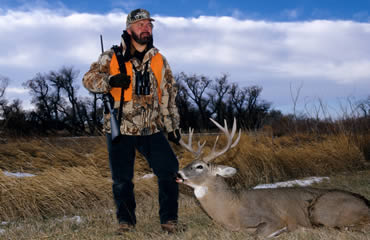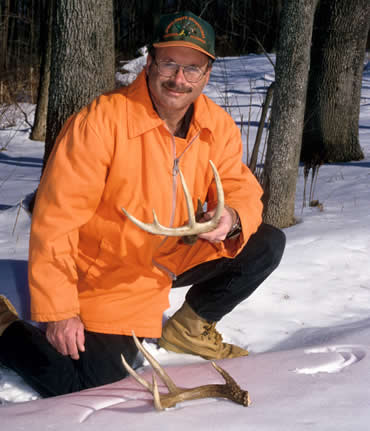Of the recognized big buck factors, which is really most important?
Several years ago, in one of my newspaper columns distributed by the Associated Press, I covered the subject of deer antlers and how they grow and are eventually dropped after the hunting season. With more than 25 years of outdoor news writing under my camo cap at the time, I long ago learned that my columns were read by hunters, anti-hunters, casual naturalists, disinterested suburbanites and kids seeking local information for homework assignments.
During that era, I also discovered that some basic natural happenings — like understanding the antler loss and re-growth phenomenon — are little known by the average newspaper reader. On this particular occasion, my weekend photo feature was run the day prior to the Pennsylvania buck season opener to draw attention to the subject.
A letter from an obviously disturbed reader arrived a few days following the story. The writer told me about an estate in northern Maryland where she worked and upon which she regularly walked and saw whitetails. She berated me for giving false information and accused me of “falling short” in my editorial duties. Furthermore, she said she’d lived on the estate for more than 12 years and not once had she found a lost tine in either summer or winter. Quite obviously, she concluded, bucks hold their racks throughout the year. Deer without racks, she concluded, are obviously immature bucks awaiting such growth, and does.
I replied with a courteous note advising her that bucks, indeed, will lose then re-grow their headgear once a year and that she should look down once in a while. I also included two photos, one with a 6-point rack and another showing the same buck with visible, raw pedicels.
I never heard from her again.
 The Age of Education
The Age of Education
Despite such instances, in recent years I’ve come to respect today’s hunters as being the most knowledgeable of any generation. Not only do deer magazines, top-quality videos and spectacularly illustrated books provide meaningful educational material, but there are many other sources of information that were not available 30 and more years ago.
Even with all that information, chances are that any heated discussions or friendly arguments among deer hunters will be about rack shapes and sizes or the peculiar phenomenon of antler growth, loss and deer body size.
There are plenty of interesting questions to be asked when it comes to buck headgear, and most hunters today know at least some of the requirements for big bucks: nutrition, habitat, genetics and age. A survey at a deer hunting seminar a couple of years back asked that question of 60 guests. Less than 25 attendees correctly named all four growth elements.
So what contribution to total rack shape, strength and size do each of the four factors offer? Which is the most important? And what are their specific contributions to producing large racks?
Age
Restraint in harvesting young bucks is the foundation of any program in which large antler size is desired. The quantum leap in rack development occurs between the ages of 2 1/2 and 3 1/2, according to Dr. Keith Causey of Auburn University. With exception in some genetically inferior deer, age is the single most important factor in yielding true trophy racks. Such a program mainly affects hunt clubs, commercial outfitters and privately managed lands on which hunters pass up shots at smaller bucks in hope that the animals will survive another year.
But age alone won’t do the trick. Just because your hunting group passes up a 2 1/2-year-old buck doesn’t mean that your neighbors will do the same.
Habitat
The maximum number of deer a range can sustain without long term damage to vegetation is known as carrying capacity. The fewer deer competing for food, the better the habitat quality. Controlled harvest of does is mandatory in any such management attempt. Timber harvests, food plots, field fertilization and even supplemental feeding will increase carrying capacity. Quality habitat provides quality food, and — in a perfect world — enough forage must be available to go around. That’s why so many hunters are willing to invest countless hours and dollars in planting food plots and/or supplemental feeding programs.
 Nutrition
Nutrition
Bucks need a protein- and carbohydrate-rich diet with the necessary minerals (calcium and phosphorous in particular) for maximum antler development. Nutrition quality is based largely on soil fertility. In the South, for example, Japanese honeysuckle is a whitetail staple. Fertilizing it, according to Dr. Causey, can increase its protein quality from 11 to 17 percent.
Strangely, studies show little relationship between a buck’s antler size and weight (as a yearling) and its antlers at age 5 1/2. Late birth dates and/or poor nutrition in a buck’s early months account for poor starts, but research at the University of Georgia has shown that late bloomers often will catch up when adequate nutrition becomes available.
Genetics (Heredity)
Although the role of genetics in the big antlers equation cannot be ignored, heredity is probably the least important of the four factors influencing trophy animals. Antler shape and number of points are largely influenced by heredity. Antler mass — or lack of it — is determined by diet quality plus age.
Via the diversity of its landscape and the abundance of biological research and record keeping performed on Texas whitetails, it’s been shown that two identical bucks fed the same diet at the same time will not typically grow the same size antlers. The difference is attributed to heredity in that the genetically deficient bucks, no matter how well they were fed, simply couldn’t produce trophy-size antlers. But it’s extremely difficult to compare bucks genetically in the wild, since no two habitat/nutrition situations are alike.
Read Recent Articles: • The 5 Ws of Decoying Deer: Who, What, When, Where, How and Why to use deer decoys
• Where Do All the Big Bucks Go?: Be prepared to get cut and dirty if you want to go where the giants roam.
• Lost and Found: How a top-10 Pa. buck almost never made it to the hunter’s wall.
This article was published in the September 2008 edition of Buckmasters Whitetail Magazine. Join today to have Buckmasters delivered to your home.